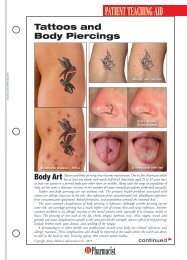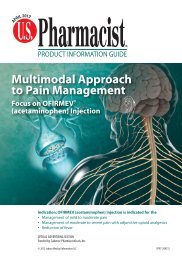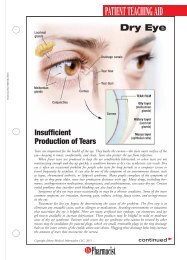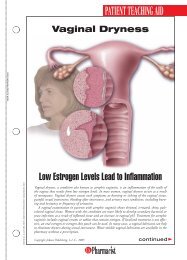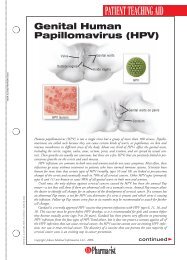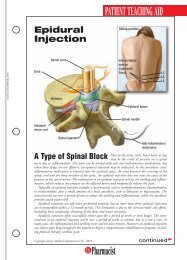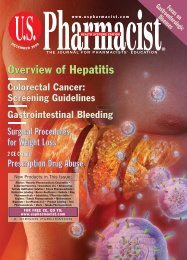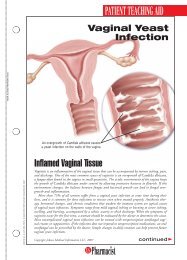View PDF Edition - U.S. Pharmacist
View PDF Edition - U.S. Pharmacist
View PDF Edition - U.S. Pharmacist
You also want an ePaper? Increase the reach of your titles
YUMPU automatically turns print PDFs into web optimized ePapers that Google loves.
EMERGENCY CONTRACEPTION: AN UPDATEonly once during a menstrual cycle. <strong>Pharmacist</strong>s shouldnot restrict the purchase of EC based on prior use orout of concern that repeated use of EC is not safe. 12There is no evidence that repeat use of EC poses increasedrisk to patients. 23 Because EC is less effective as birthcontrol than ongoing methods of contraception (suchas condoms or birth control pills), it is recommendedonly as a backup method and not as a substitute forongoing, more effective methods. EC can be purchasedin advance and kept at home in case the need arises, asthis avoids the delay of going to the pharmacy.There are few contraindications to the use of EC.The WHO Medical Criteria for Contraceptive Use 2005stated that there are “no conditions where the risks ofEC outweigh the benefits.” 23 Product labeling lists thecontraindications as an established pregnancy or knownallergy to the ingredients in EC. There are no studiesof EC use by women with migraine headaches, smokersover age 35, or other precautions applicable to theregular use of combination oral contraceptives. However,these conditions should not limit the use of EC.Timing of the EC DoseLevonorgestrel is thought to be more effective the soonerit is taken, therefore pharmacists should encouragewomen take EC as soon as possible after unprotectedintercourse. 24 The FDA-approved dosing recommendsinitiating therapy within 72 hours of unprotected intercourse.For levonorgestrel 0.75 mg tablets, a seconddose is required 12 hours after the initial dose. 5,8 Althoughthere is evidence of efficacy as late as 120 hours afterintercourse, women should be encouraged to seek treatmentas soon as possible, preferably within the 72-hourtimeframe. 21,25-28 Since the time required from intercourseor ovulation to implantation is approximately6 to 7 days, use of hormonal EC beyond 120 hours isnot likely to be effective. 13Studies evaluating single-dose levonorgestrel (1.5mg) have concluded that the single dose is not less effectivethan the two-dose regimen. 21,28,29 Plan B One-Stephas been approved for use as a single 1.5 mg dose forEC. The single dose formula may improve complianceby simplifying the EC regimen and will replace the PlanB 0.75 mg levonorgestrel preparation.Concerns have been raised that providing EC towomen in advance of need to keep on hand “just incase” of a contraceptive failure might lead to an increasein unprotected intercourse or encourage women to discontinuethe use of their usual method of contraception.However, studies evaluating the outcomes ofproviding EC in advance of need have not found thatwomen engage in more unprotected intercourse or abandontheir usual method. 6,7,30,31 These studies havereported that women are more likely to use EC afterunprotected intercourse if it is provided in advance ofneed. Based upon the findings of the studies, providingEC in advance of need can be recommended toimprove timely access to the product.Dual Status: EC in the PharmacyThe dual status of levonorgestrel-only EC necessitatesthat products be kept within the pharmacy or behindthe counter. In the pharmacy a consumer has access tothe pharmacist, a knowledgeable health care provider,to answer questions regarding the use of EC. ECproducts must only be sold in pharmacies or licensedclinics and are not available at other types of retail establishments.Keeping EC hidden behind the pharmacycounter may pose a barrier to some consumers becausethey may expect to find the products on pharmacyshelves or within sight behind the pharmacy counter.<strong>Pharmacist</strong>s are encouraged to provide shelf tags or displayEC products in a conspicuous location to facilitateaccess by consumers who may be reluctant to askif they do not easily see the product in the pharmacy.“CARE” Program: ConvenientAccess, Responsible EducationThe terms of the FDA approval of Plan B for OTCaccess by consumers age 17 and older included requirementsrestricting the distribution of EC, meeting labelingrequirements for both OTC and prescription use,and for the manufacturer to provide support and educationabout the use of the product to health careproviders and consumers and to continue ongoing monitoring.The dual-labeled, behind-the-counter labelinglaunched with the approval of Plan B was the firsttime the FDA had approved the same product packagefor both OTC and prescription-only use. Theapproved packaging includes room for a prescriptionlabel (to be used when the product is dispensed byprescription), as well as the required Drug Facts box forOTC sales.The CARE program specifies that EC is to be soldonly from behind the counter in the pharmacy andnot be available through nonpharmacy retail outlets.The FDA approval allows EC to be sold without aprescription to women or men 17 or over as long asthey can show proof of age. 2 Pharmacies must have apharmacist on duty and available for consumer consultationin order to sell EC. Although the pharmacistmust be available, it is not required that the pharmacistbe the person who sells the product, or for the consumerto consult with the pharmacist. Any member ofthe pharmacy staff working behind the pharmacy countermay sell the products to eligible consumers as long asa pharmacist is on duty and available for consultationif requested by the purchaser.Medical clinics may also sell EC if there is alicensed health care provider on the premises for consumerconsultation at the time of sale. Retail outletswith pharmacies where the retail store has longer73U.S. <strong>Pharmacist</strong> • November 2009 • www.uspharmacist.com




